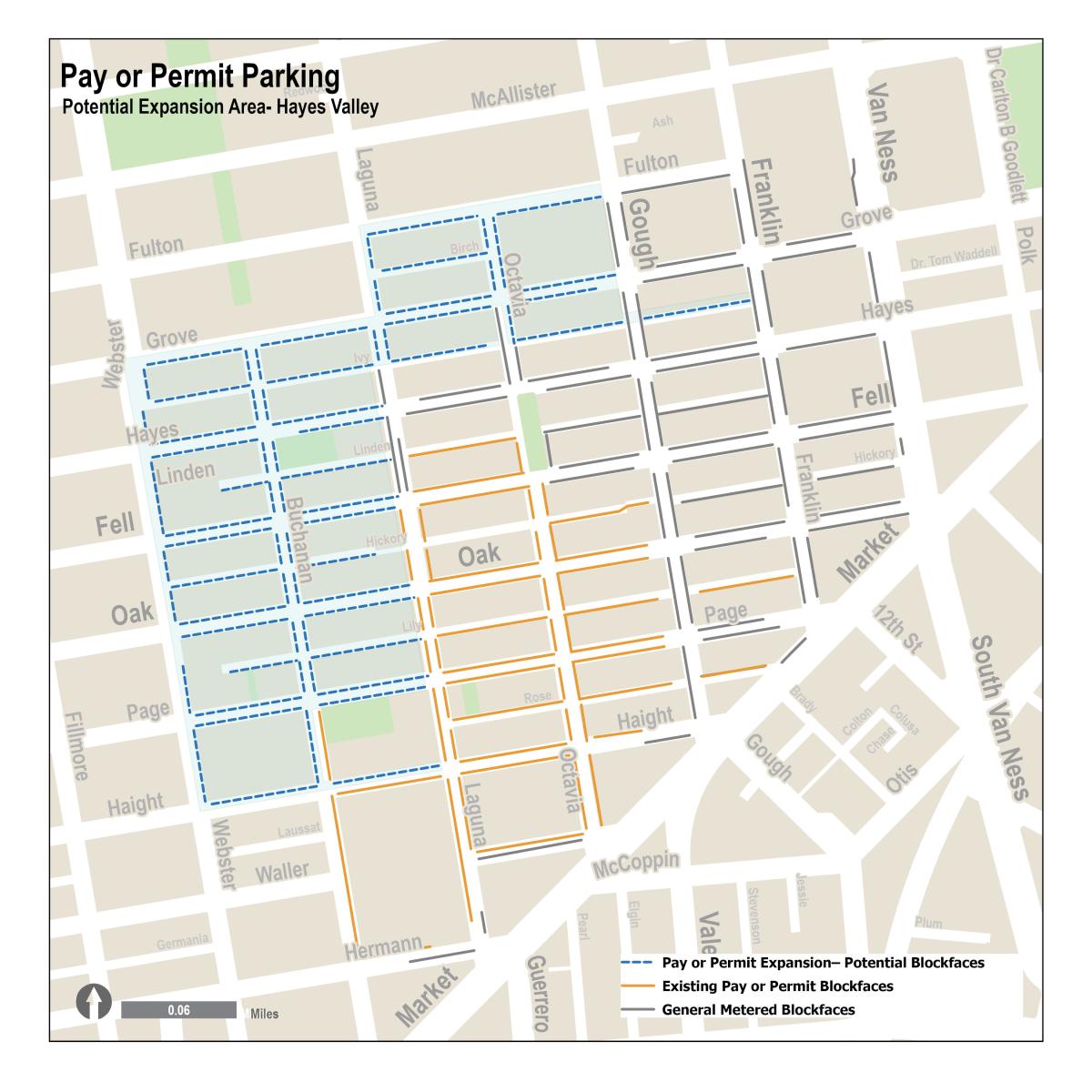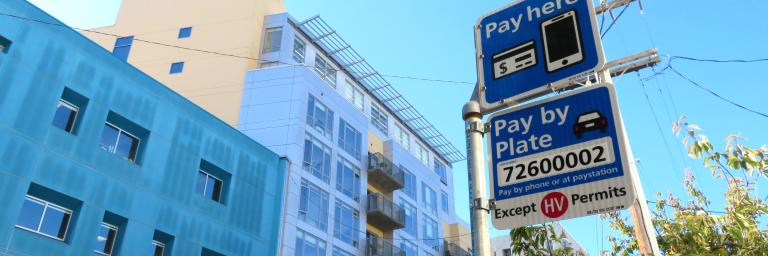At a Glance
The San Francisco Municipal Transportation Agency (SFMTA) is studying the feasibility of replacing parking time limits with visitor-paid parking on Residential Permit Parking (RPP) blocks in Hayes Valley’s HV Permit Area. This regulation, known as Pay or Permit Parking, is already used on about 30 blocks in the neighborhood.
Pay or Permit Parking makes it easier for both residents and visitors to find a parking space. Residents with permits can park without paying the hourly rate, while visitors pay for the time they need.
How Pay or Permit Parking Works
For Permit Holders: If you are an existing Residential Parking Permit (RPP) holder, nothing changes for your permit eligibility or cost. You can continue to park without time limits or hourly payment.
For Visitors: Visitors can park without a time limit and simply pay for their desired parking duration via the nearby pay station or mobile app. Paystations accept multiple forms of payment, and individual spaces are not marked.
Current Rates: $1 to $3.25 per hour (average: $2per hour)
Hours Payment is Required: 9 a.m. to 9 p.m. Monday through Saturday, the same as the current HV RPP time limits.
For more information, check out the Pay or Permit Parking FAQs
Project Background
In early 2023, the SFMTA introduced Pay or Permit Parking on several blocks in Hayes Valley as part of the Hayes Valley Parking & Curb Management Plan. The goal was to make parking easier where traditional 2-hour RPP time limits weren’t working well. With time limits, visitors often stay longer than allowed, while residents struggle to find parking near their homes even with a permit. Most RPP blocks near commercial corridors are occupied by non-residents, and many park beyond the posted time limits.
Pay or Permit Parking has made street parking easier for everyone. After it was introduced:
- The number of available parking spaces increased by an average of 5%, or about 1 additional open parking space per block.
- The number of vehicles showing permits increased by 10%, even though the total number of HV permits did not change. This suggests residents were finding parking more easily with Pay or Permit.
- All addresses on Pay or Permit Blocks were sent a survey. Most respondents either supported the change or had no opinion.
Visitors also benefited. Without time limits, twice as many visitors stayed for 2-4 hours to shop, dine, and socialize compared to traditional RPP blocks. At the same time, fewer vehicles were parked all day, freeing up more parking spaces for residents and short-term visitors. Vehicles parked all day are often commuters who would otherwise occupy spaces intended for residents and customers.
In 2023, the SFMTA received a $1.5 million Local Parking Management Capital and Implementation Grant from the Metropolitan Transportation Commission (MTC) to extend Pay or Permit Parking to more areas. As part of the grant, MTC will study impacts to congestion and air quality.
Pay or Permit Parking Benefits
For Residents:
- Increased parking availability makes it easier to find parking near home for residents and their guests.
- Less circling for parking, which helps reduce congestion and pollution on residential streets.
For Businesses:
- Easier access for customers, encouraging more frequent visits and supporting overall neighborhood vitality.
- Flexibility for employees and customers who no longer need to move their car every two hours or risk a ticket.
For Visitors:
- Avoid the stress of tracking and moving your car every two hours and the risk of a ticket.
- Parking is easier to find, giving more time to enjoy the neighborhood.
- Caregiver and visitor permits remain available for longer visits.
New Discount Pilots
Through our outreach, we've heard two main concerns:
- Local businesses want to make sure employees can get to work easily.
- Residents are concerned about losing access to two hours of free guest parking.
In response, the project team is developing two new discount programs to pilot alongside any expansion of Pay or Permit Parking. The discounts aim to address concerns while improving overall parking availability.
Small Business Discount: Businesses in the HV Permit Area would be eligible to sign up to receive 50% off parking fees for up to 5 employees on Pay or Permit blocks in the HV Area.
Resident Guest Discount: Residents in the HV Permit Area could sign up with proof of address to receive 12 free two-hour parking codes per year. These codes can be shared with guests to share with guests.
Pay or Permit Expansion Project and Timeline
The SFMTA is studying the expansion of Pay or Permit Parking to additional blocks of Hayes Valley shown in the map below. Community outreach will continue through 2025 and 2026, and the proposal will be refined based on public feedback.
The project team is also exploring opportunities to bring Pay or Permit Parking to other neighborhoods in the future, based on community interest.

Timeline
- Planning
- 目前 (Current)
